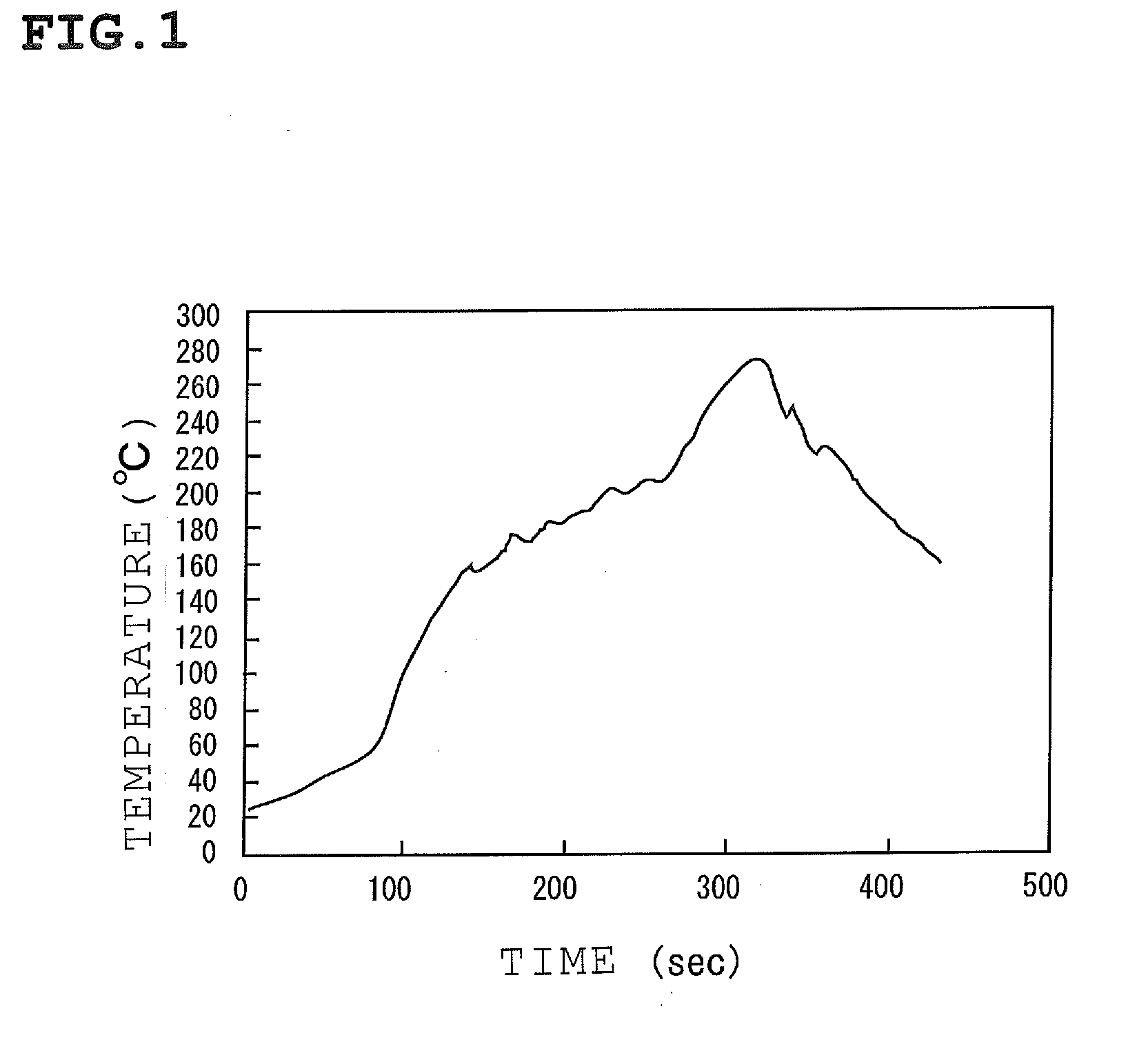[0014]The inventors of the present invention conducted a series of studies to solve the aforementioned problem. As a result, the inventors found that, where the
linear polymer (A), the
epoxy resin (B) and the polymerizable compound (C) containing the ethylenically unsaturated group are employed in combination for preparation of the photosensitive resin composition and the proportions of these components (A) to (C) are determined so that the photosensitive resin composition has a tensile breaking elongation percentage of not less than 10% and a 2%
weight loss temperature of not lower than 260° C. after being cured by photopolymerization, the photosensitive resin composition has properties generally necessary for a solder resist (insulative property, solder
heat resistance and alkali developability) and, like a cover lay film, a film formed by curing the photosensitive resin composition is excellent in flexibility and in folding endurance even after the IR reflow process. The excellent folding endurance even after the IR reflow process is thought to be attributable to the higher tensile breaking elongation percentage, which makes the cured photosensitive resin composition less susceptible to
cracking which may otherwise occur due to a stress applied during a folding test. The excellent folding endurance is also attributable to the higher 2%
weight loss temperature, which makes the cured photosensitive resin composition less susceptible to thermal degradation even after the IR reflow process. Therefore, a flexible circuit board can be produced as having a surface protective layer (cover insulating layer) excellent in folding endurance even after the IR reflow process by forming a solder resist film from the photosensitive resin composition on the surface thereof formed with the
electrically conductive circuit pattern.
[0015]As described above, the inventive photosensitive resin composition contains the
linear polymer (A), the
epoxy resin (B) and the polymerizable compound (C) containing the ethylenically unsaturated group, and has a tensile breaking elongation percentage of not less than 10% and a 2% weight loss temperature of not lower than 260° C. after being cured. Therefore, the cured photosensitive resin composition has insulative property, solder
heat resistance, alkali developability and other properties necessary for the solder resist, and is excellent in flexibility and particularly in folding endurance even after the IR reflow process. Therefore, the flexible circuit board can be produced having a surface protective layer (cover insulating layer) excellent in folding endurance even after the IR reflow process by forming a solder resist film from the inventive photosensitive resin composition on the surface thereof formed with the
electrically conductive circuit pattern. Therefore, the solder resist film formed from the photosensitive resin composition can be provided instead of the cover lay film which is conventionally used as the surface protective layer formed in the folding portion of the flexible circuit board. This solves the problem that the combinational use of the cover lay film and the solder resist increases the number of the steps of the production process, thereby reducing the production costs. A
mount board produced by mounting an
electronic component on the flexible circuit board can be easily folded to be thereby properly accommodated in a narrow space. Therefore, the flexible circuit board is advantageously used as a
mount board for a smaller size device such as a
mobile phone.
[0016]Where the specific linear
polymer (A) has a
carboxylic acid equivalent of 400 to 1000, the photosensitive resin composition is well balanced between the flexibility and the alkali developability.
[0017]Where the epoxy resin (B) has an epoxy equivalent of 450 to 2300 and is in a
solid state at 25° C., the photosensitive resin composition is better balanced between the flexibility and the alkali developability.
[0018]Where the epoxy resin (B) is a
bisphenol-A epoxy resin or a
bisphenol-F epoxy resin, the photosensitive resin composition is well balanced between the flexibility and the heat resistance.
[0019]The properties of the inventive photosensitive resin composition make it possible to efficiently produce the flexible circuit board through a production method employing an
exposure / development process, which includes the step of forming a cover insulating layer by forming a layer of the photosensitive resin composition on an electrically conductive circuit
pattern formation surface, and exposing and developing the photosensitive resin composition layer in a predetermined pattern to cure an exposed portion of the photosensitive resin composition layer.
 Login to View More
Login to View More 


